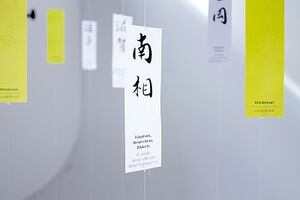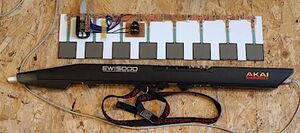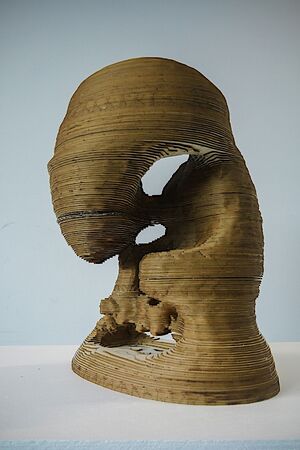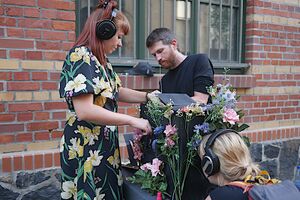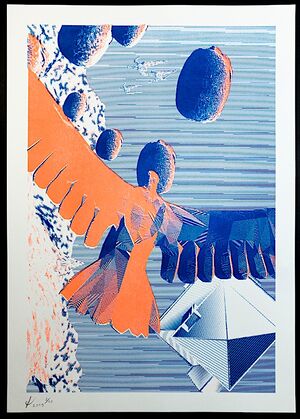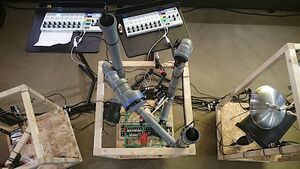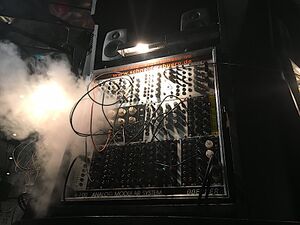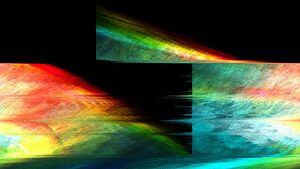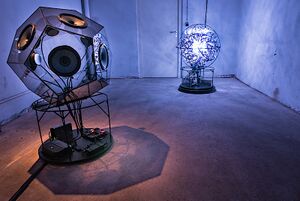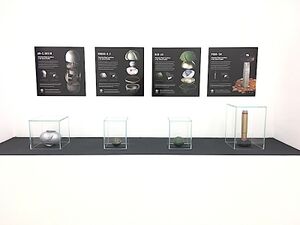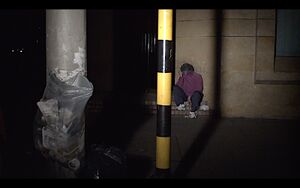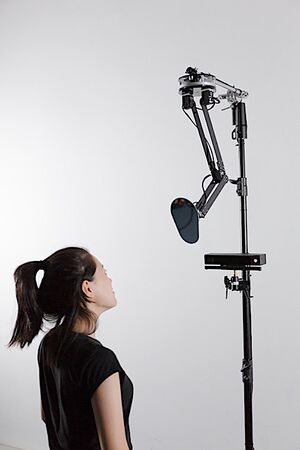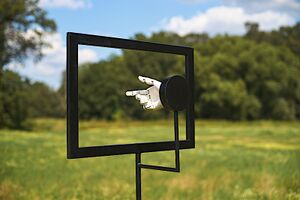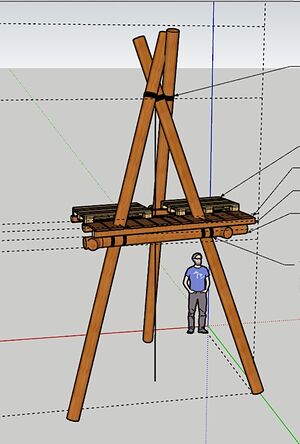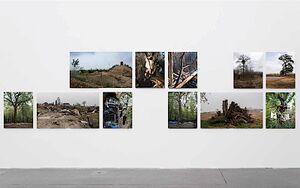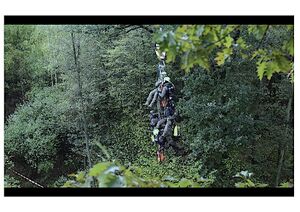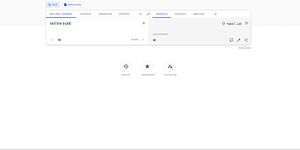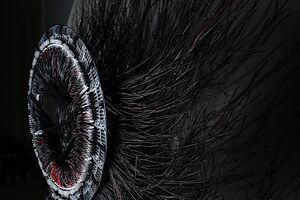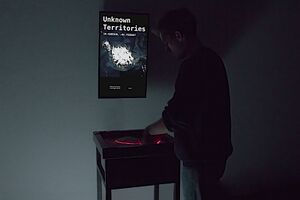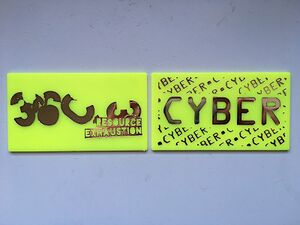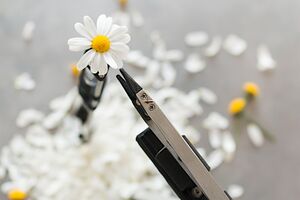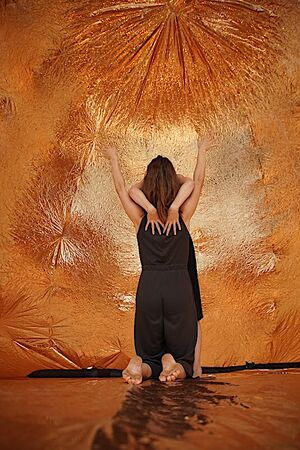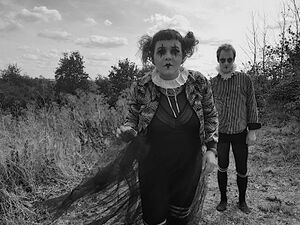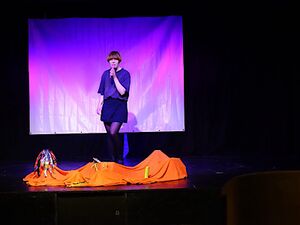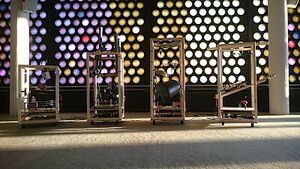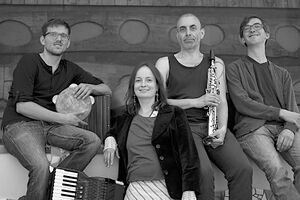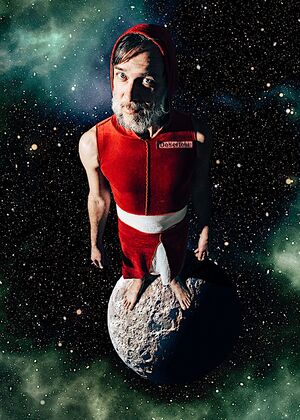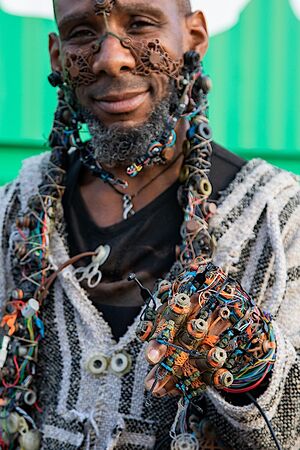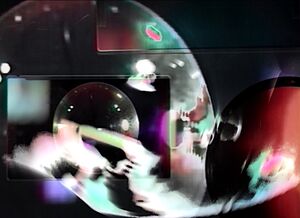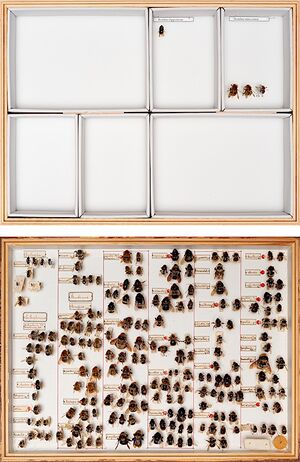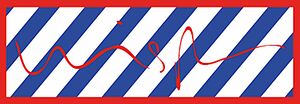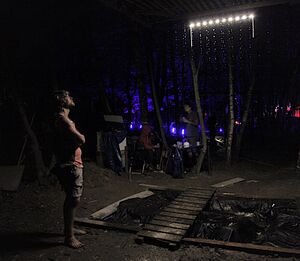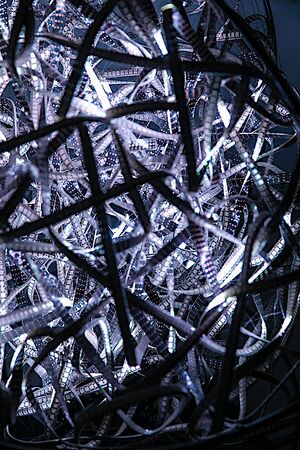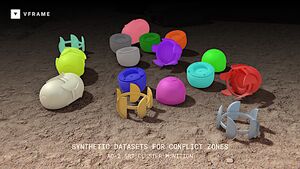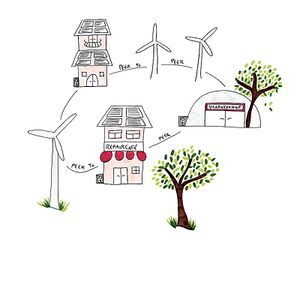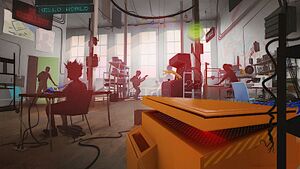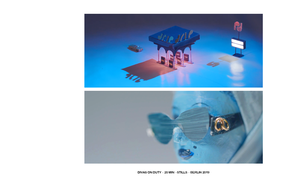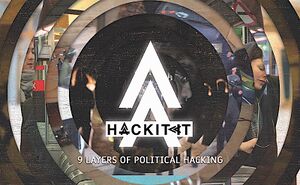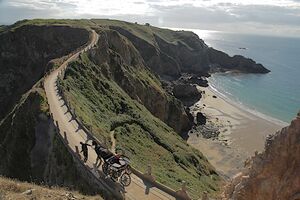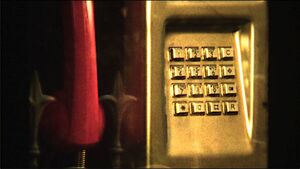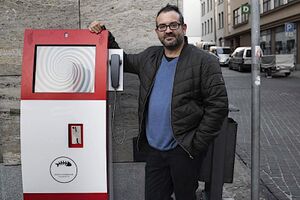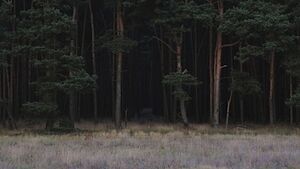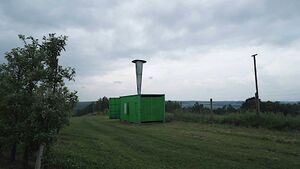Assembly:Art-and-Play
| Website | |
|---|---|
| Contact | contact@kollektivartesmobiles.com |
| Description | The place for art installation, perfomance, films, workshops and talks |
| Members | |
| Projects | Superkarussell |
| Self-organized Sessions | Art Inspired by Assange and Wikileaks, Physics for JungHacker*innen, Technological Narratives: Solarpunk, Cyberpunk, Popculture |
| Tags | art, beauty, installation, performance, theatre, culture |
| Provides stage | no |
| Location for self-organized sessions | no |
(Click here to refresh this page.)
Contents
About
Exhibition area for installations, robots, artificial intelligence, music jams, noises, hobbyists* and of course a lot of nerds.
Stage Program: lectures, film screenings, theatre, dance performance, live music
Installations
Lucky Island
interactive media — kinetic sound installation
Michaela Lautenschlager
Outside of our visible spectrum of light there is a very big area of electromagnetic radiation. Scientifically it is light as well, as it consists of photons. The most dangerous part for the human being: gamma rays. They are characterised by a very small wave length and permeate almost all materials on earth. We cannot see them and generally only notice them when they are linked to radioactivity; when we deal with the consequences of atomic bombs and nuclear power plants.
In this project I try not to value the consequences of the exposure to it but I want to build relations to better understand radioactivity. Therefore, I use the principle of sonification in order to make live measurements of monitoring stations in Japan “audible”.
10 stations in Japan deliver measurements of radioactivity in their environment. Every time there is a new value coming in, the according bell in my installation rings. With the AR-app you can read the latest values of each sensor and get interesting reference values for better understanding.
To create the highest possible tension between the layer of information you get when reviewing the measurements and the poetic installation itself, I used traditional Japanese wind chimes. They make the installation appear fragile and subtle, while bringing the sound into the analogue and thus making it more tangible and present for the viewer.
Data by: safecast.org
Michaela Lautenschlager is a communications design student from Würzburg, specialising in interactive media and exhibition design. In her work she transforms information into interactive spatial installations between media art and data visualisation that make complex topics tangible and present.
www.michiinjapan.de
#michi_in_japan
DIY – hard & software project
Michi Breitenbach
musician, composer, programmer
exploring sound with analogue synth, laptop and analogue oscilloscope see and hear oscilloscope music try self made microcontroller based controllers and sound programming on laptop interests in this context: csound, max/msp, granular synthesis, arduino, teensy, …
Whispers
sound installation
Katrin Caspar & Eeva-Liisa Puhakka
Whispers consists of a dozen small modules suspended on thin transparent threads in a space. Each module – originally taken from children’s speaking toys – has a speaker, a microphone, a motor and a small computing unit (circuit). Together they build up an autonomous system listening to bird sounds transmitted by one static speaker in the room. The modules work as performers, receiving and playing back all nearby sounds they can pick up, creating a situation of live sampling. Thereby every module works on its own, autonomous and independently but mimicking the other ones. Movement is created by the built in motors which take the sound input as the triggering moment. Like birds in the forest the modules try to impress each other getting louder, screaming more, or becoming quiet. It is hard to locate a single sound or a single module, they work all together creating a network of information. The system itself is an open system and can be modified by the sound input of the visitors. The self-reflecting systems transforms into a participatory space.
Katrin Caspar is an artist who works with electromechanical material creating mainly kinetic sculptures and sound installations, often inspired by everyday objects. She is interested in systems and network structures, their organization and potential rules and on a more complex level on their behaviours, how they act and perform and their possibilities for storytelling and performance. Katrin graduated from the University of Arts Bremen with Bachelor of Digital Media and received a Master in Fine Arts from the Valand School of Fine Arts in Göteborg. Her works have been shown amongst others at OHP Festival, Media Lab Prado, Pixelache Festival, Ostrale Dresden, LEAP Berlin, Kunstwerke Berlin, Transmediale, VIA/ EXIT, Festival and WRO Media Art Biennale.
Eeva-Liisa Puhakka works in mediums that include installations, kinetic sculpture and video. Puhakka is a member of Scent Club Berlin, a collective that focuses on scent and olfaction as an expressive medium for experimentation in art. A specific focus in her recent work has been the investigation of human and animal dependence together with global environmental changes on bird populations and bird migration in correlation to human migration. She has also been researching a religious sect and its child preachers, and smell of fear and death.
Eeva-Liisa Puhakka graduated with an MFA from University of Gothenburg, Sweden and an MSc from Helsinki University of Technology, Finland. She lives and works in Berlin, Germany and Kouvola, Finland. Previous projects include exhibitions at Transmediale Vorspiele Berlin, KW Berlin, WRO Media Art Festival, VIA/EXIT media art festivals, Ostrale Dresden, Galleri Box Göteborg, Nakanojo Biennale, Japan and SeMA, Seoul Museum of Art, South Korea. In 2017 she exhibited solo with Kleiner Salon, Berlin and was shortlisted for Below Zero art prize, London. Puhakka works regularly in a curatorial/production role and projects have included Nordic Environmental Art and Science Symposium, Helsinki, Deliver Us From Evil exhibitions at Antares Art Center, Finland, Landscape-Metropolis exhibition, Berlin and Ars Lieke media art exhibition, Kouvola Art Museum, Finland.
https://vimeo.com/164809651
http://www.eeva-liisa.net/
https://www.katrincaspar.net/
When Interference Finds Interpretation
netscape art/digital landscape art
Mathias Warnich
When Interference Finds Interpretation is a project that deals with the ever growing amount of signals that surround us in modern everyday life. In general these go unnoticed and are only thought about in their absence. The project derives from this premise that we, to some extent, exist on two different planes – the physical and the digital. But these two planes are becoming more and more intertwined. We find our communities, friends, interests, news etc. online – yet our understanding of what connects us to the internet moves very slowly. The cultural implementation of technology has now vastly overtaken our cultural understanding of technology. This project is an experiment to give a physical body to some of the invisible parts that surround us in our everyday life. To try and break down the separation between the digital and physical – to blur the lines that separate the two. A desire to raise questions of our understanding of the technologies we interact with on an everyday basis. What would it look like if WIFI had a form? When Interference Finds Interpretation is a open-source and international endeavour to map and give form to places’ WIFI signature. You are invited to be part of the project and experiment, play, reform, extend etc. in anyway you see fit.
www.wi-form.com
https://github.com/Wi-Form/Wi-Form
www.mathiaswarnich.dk
#mathiaswarnich
Field Trip
interactive documentary
Team Field Trip: Eva Stotz, Frédéric Dubois, Joscha Jäger, Svenja Klüh
Field Trip is an interactive documentary film about Tempelhof Field, a former airfield now being used as one of the biggest urban parks in the world. For some, the 300 hectares of open space are full of possibilities; for others, it is a place of oppression and of dark episodes in German history. For others still, it has become a home far away from home. Field Trip tells their stories. Through interactive documentary films and the inclusion of people on site, Field Trip has become a vibrant reflection of one of the most exciting places in Berlin. Field Trip is a ronjafilm production and was initiated by a group of Berlin media makers coming from Documentary film, Journalism and Creative Technology. The Field Trip team has made a large part of the materials (films, illustrations, software, design) available to the public. Most of the materials are published under open licenses.
Open licenses strategy
In the Field Trip team, we like to see ourselves as commons-based creatives. This is why, the idea we have for our project is to create a permanently open, living documentary, based on open web technologies. This means that all interactive options, visualisations, transitions, effects and almost everything else is implemented through small, re-usable snippets of code. Instead of conventional post-production software, we are using HTML, Javascript and CSS wherever technologically feasible. In addition, we are making these code snippets available in an open repository under MIT and GPL v3 licenses.
When it comes to the documentary reality, while all code behind our interactive documentary is published under open source licences, the conditions for content (e.g. video material, photographs, texts) vary more than we would have liked: we normally use the "Creative Commons Attribution-ShareAlike 4.0 International License", which allows the free use, editing and distribution (including commercially) of content, as long as the authors are correctly named and the works are passed on under the same conditions. The majority of Field Trip content is thereby under that CC license. On top of the material used in the documentary, we put rough cut and b-roll material under the said Creative Commons license.
However, in the case of archival material, sensitive material (i.e., where we explicitly needed to protect a protagonist), content obtained through other channels (e.g., private video material), we had to compromise. Any restrictions of this kind are clearly communicated in the list of all materials and licences in our media repository, to be launched in full extent at the 36th Chaos Computer Conference in December 2019.
https://fieldtrip.berlin
@FieldTripBerlin
day 2_ 28.12 15:00 interactive screening and Q&A
Lambe Lambe: Conglomerate of Experiences: BLODEUWEDD/Dideldum/The Abyss/Anasyrma Temple
puppetry
Cie. What's in my box
There will be individual shows from 5 to 10 minutes for 1 spectator at a time of the following pieces:
BLODEUWEDD (Blod-day-weth) Experience the story of a mystical woman made of flowers, told for you alone with handmade miniature puppets. Part of an ancient legend from Wales, Blodeuwedd is a tale of identity, hardship and free will.
With: Owain Griffiths, Hannah Morris
---
Dideldum: We are full of memories. Memories of sounds, songs, voices, faces, events, smells and people. Memories pile up, branch out and yet they belong together. All these memories define us, define who we were and who we actually are. But what happens when forgetting threatens us, when our everyday life suddenly seems alien to us, when our minds flutter away and we cannot think clearly anymore? What remains of us?
With: Eva-Maria Schneider
www.eva-mariaschneider.de
---
The Abyss: A small glimpse into an archive of fear and nightmares. Within their participative installations “Private Dreams & Public Nightmares” Jan Jedenak and Jonas Klinkenberg invite their audience to get in touch with different forms of fear and reflect on nightmares, their own fears and the fears within our society. During different experiments those things are documented. This Lambe, built by Jonas Klinkenberg, allows a glimpse into the archive of fear – with a small touch of Poe and Lovecraft and bits of an old radio feature. Open your eyes and dive into the depth of nightmares and get to know different perspectives on what scares us. Look into the abyss.
With: Jonas Klinkenberg, Jan Jedenak
---
Anasyrma Temple: Come, get rid of your sorrows, leave all your worries behind. Dive into the universe of Anasyrma Temple and be healed!
With: Dana Sinaida Ersing
---
Lambe Lambe – this is theatre for individualists. For those who are reluctant to share theatre experience with a large audience. A show, just for one person at a time. A moment just for you! Lambe Lambe is a theatre technique that has been revived and celebrated since the 1990s, especially in Latin America. It is widespread all over the world and has recently been on the rise again. In miniature theatre boxes, figures and objects are played in short scenes for only one spectator at a time. Meet a strong woman out of an old myth from Wales, face memories and nightmares and let yourself be disco-healed. Compagnie What's in my box is based in Leipzig and invites you to choose your box and enter worlds that are made just for you.
https://www.facebook.com/leckileckikolleki
day 1 - day 4_ 27. / 28. / 29. / 30._ 6 to 9pm [5-10min per individual show]
Distinction Machine
browser art, Custom Software, Browser Art, Risograph Prints
Kim Albrecht, metaLAB (at) Harvard
By rendering shapes of different colours in the same location, the computer reveals its incapacity of representing ambiguity. In these experiments, a computer-mediated aesthetic of strange and intricate patterns emerges.
Kim Albrecht visualizes cultural, technological, and scientific forms of knowledge. His diagrams are meant to unfold and question the structures of representation and explore the aesthetic of the intermingling of technology and society through the sensual knowledge of tracing information.
https://kimalbrecht.com
Twitter: @kimay
#kimfalbrecht
Augmented Aurality
interactive sound installation
Kollektiv Eigenklang
Augmented Aurality is a very open concept which is based on interaction and experimenting. We want to co-create with all kinds of human expression and are happy to connect with the 36C3.
Kollektiv Eigenklang is an audio-visual performance collective, setting up its spaceship to explore the unlimited possibilities of improvised and interactive live producing, manipulating your senses and creating psychedelic Soundscapes of organic, electronic and human sounds between your ears.
http://www.kollektiv-eigenklang.com
https://www.youtube.com/channel/UC_F_zahLuXzp0TQifGXdYyA
https://soundcloud.com/eigenklang
Elektroakustische Wucherung
interactive sound sculpure
Schaltkreis Musik
Playing cards, sewer pipes, a plant pot, canisters, pans, peanutbutter jars, vases, washers …
Schaltkreis Musik create quirky motorized instruments from items and strangely familiar found objects. These machines can be played like drum computers through rhythm-sequencers. Combined with microphones and effects a versatile beat instrument is formed, that can be played – even with no musical experience.
Schaltkreis Musik come to 36C3 with the current version of their installation, which will be further developed and expanded with new electromechanical instruments on site. Curious visitors can join and explore musical-compositional aspects of the already existing sculpture or participate in the sculptural development of their own novel instruments.
https://facebook.com/schaltkreismusik
instagram: @schaltkreismusik
The Pig Simulator
VR game
Stephan Isermann, Andreas Pavlou, Tim Tekkler
The Pig Simulator takes place in virtual reality, but also in real space. Once inside the physical rig users are forced not only to embody the pig in the audiovisual virtual realm, but also to take a quadruped pose in real space. The goal is then to escape the slaughter in virtual reality – and, as in the real life of the real pig, this idea becomes futile. The user will live and die like a pig and experience the habitat of the animal as closely as possible through virtual embodiment, an artificial and at the same time cruel habitat designed by us for the human desire for mass consumption of meat. The goal of the pig simulator is not to educate or strive for higher values as much as it is to disappoint common expectations about gaming and to fight the dark irony of a just world of unequal life forms living in the shared habitat called Earth.
SuperKarussell
Synthesizer Installation
SchneidersBüro
The SuperKarussell is a rotating synthesizer installation from SchneidersBuero and SchneidersLaden. Six modular synthesizers are playable on this machine. The result is then output by speakers and a radio signal on 87.52 MHz.
https://twitter.com/superkarussell
.inf
ever-changing audiovisual sculpture
Felix Deufel & Paul Schengber (Wisp Kollektiv)
Over 2 million virtual points are floating inside an empty three dimensional space. Random numbers, received in real-time from atmospheric noise, are calculating changes of the points position, speed, lighting, colours and perspectives of three cameras. This causes unpredictable resulting images, visualizing atmospheric noise as a living organism. Every frame is unique and not reproducible. Sound synthesis and events are linked with the parameters of the floating points. .inf is a real-time, ever-changing audiovisual sculpture. The images and sound create a flow where time is felt as relative as it is.
Paul Schengber, creative coder and visual artist and Felix Deufel, sound artist and audio engineer started their intense collaboration in 2014 with exploring innovative new media formats, dealing with future technologies and bridging disciplines. Paul Schengber and Felix Deufel are the founders of Wisp, a studio for digital art, design & culture based in Leipzig, Germany. Their creative works and programs intersect technology, science and philosophy. For several years the studio creates free and commissioned artistic works with sound and light in space such as installations, compositions, sound designs, performances and concert productions for exhibitions and live shows. The interdisciplinary team is specialized on 3D audio, visual and interaction design. Currently Wisp is developing a software for 3D audio live performance and studio production. As a cultural institution Wisp hosts an annually growing program of artist residencies, digital art labs, workshops and events.
Speculative Artificial Intelligence / Exp. #2 (conversation)
Installation/Aesthetic Research
Birk Schmithüsen
This work consists of a series of aesthetic experiments designed to make processes of artificial neural networks perceptible to humans through audiovisual translation. Exp. #1 examines inner behavior during the prediction and learning process. In the experiment, a network is visualized by a light object, with the state of each neuron represented by a corresponding LED. Exp. #2 questions an AI’s capacity for empathy and purpose while communicating with a second AI. Both systems are embodied by a light or sound object and can receive the messages of the other. The spherical light object with a diameter of 80cm consists of a chaotic heap of 95m LED Stripe, a microphone and an embedded AI computing device. It can hear sounds and create images. The sound object in the form of a dodecahedron of black, opaque Plexiglas with the same diameter is equipped with eight speakers, a camera and the second AI system. It can see images and play sounds. In the exhibition, the two systems are in an ever-changing audiovisual conversation.
Conceptual support by Artificial Intelligence Center, University of Oviedo at Gijon. 3D calibration of volumetric display by Felix Bonowski. Coding by Marcus Ding. Realized at LABoral Centro de Arte y Creacion Industrial in Spain within the framework of the European Media Art Platform EMARE program with support of the Creative Europe Culture Program of the European Union. Additional production support by ArtesMobiles.
Birk Schmithüsen is an audiovisual artist based in Leipzig, Germany. His work explores emerging technologies that affect our everyday lives. For his artistic research, he uses non-perceptible, abstract concepts such as Artificial Intelligence, Big Data and Computer Vision as artistic media. He converts his concepts into immersive installations with new media.
http://www.birkschmithuesen.com
https://github.com/birkschmithuesen
https://www.facebook.com/birk.schmithusen
https://www.instagram.com/birk_schmithuesen
day 2_ 28.12_ 14:00 Artist Talk: AI in Artistic Practice @ Art & Play Stage
VFRAME: Locating Illegal Munitions with Computer Vision
Installation: computer vision, AI, object detection, human rights, OSINT
Adam Harvey, Josh Labouve
VFRAME is a computer vision toolkit designed for human rights researchers. To locate highly specific items in conflict zone videos, such as cluster munitions, VFRAME uses 3D modeling to create synthetic training datasets. These datasets help fine-tune object detection algorithms to locate the 4 munitions featured here: AO-25RT, PTAB-1M, ShOAB-0.5, and BLU-63.
Adam Harvey is an American artist and researcher currently based in Berlin. He is a graduate of the Interactive Telecommunications Program at New York University and previously studied engineering and photojournalism at Pennsylvania State University. Harvey's previous work includes CV Dazzle (camouflage from face detection) and the Anti-Drone Burqa (camouflage from thermal cameras). His work has been exhibited at the Istanbul Design Biennale, German Spy Museum, V&A Museum and commissioned by the New York Times. Harvey recently founded VFRAME.io, a computer vision toolkit for human rights researchers, that received an award of distinction from Ars Electronica in 2019.
https://vframe.io
https://ahprojects.com
Calle 22
HD Video, 40 min
Julius von Bismarck
Calle 22 is Julius von Bismarck’s documentation of the street of the same name in Bogota, Colombia. With a high-speed camera and a spotlight he shoots over 2500 frames per second during a car ride at high speed along the southern side of Calle 22 at night, thus capturing the varied life on the road with a powerful light. As this leads from the prosperous parts of the city to the poor quarters, he presents the urban development in a very small space and reflects the political process of a city based on one road. Von Bismarck questions the outside gaze on the social strata of another country by capturing images in slow motion, that seem to show an almost frozen scenery. Since the camera captures the street in one continuous tracking shot, there is no possibility for selection. Von Bismarck refers to Western photography in poorer countries, which lures to trigger a certain emotion or reaction of the viewer by selecting their motifs. The spotlight produces an aggressive interference in the private life of the local people as it is often the case with Western reports of other cultures. Through the fast drive of the pickup and the conical light of the spotlight, individual scenes are focused and the people of Bogota portrayed as if by accident, because until they have realized the moment of the shot, the camera is already ahead.
Julius von Bismarck was born in 1983 in Breisach am Rhein (Germany), he currently lives in Berlin. He is a graduate of the Berlin University of the Arts (UDK) and the Institute for Spatial Experiments funded by Olafur Eliasson, who was his teacher until his Master’s degree in 2013. Associating visual arts to other fields of research and experimentation, such as physical and social sciences, Julius von Bismarck’s artistic practice can take on various forms – from installations to happenings, from sculpture to Land Art. It is defined by an in-depth and complex exploration of the phenomena of perception, or the representation and reconstruction of reality. The artist has had numerous of solo shows, including the Palais de Tokyo Paris (2019), Kunstpalais Erlangen (2018), the Städtische Galerie Wolfsburg (2017), the Kunstverein Göttingen (2015). He has also taken part in international group exhibitions, among which “Power to the People” (Schirn Kunsthalle, Frankfort, 2018), the 1st Antarctic Biennale (2017), “The End of the World” (Centro per l’Arte Contemporanea Luigi Pecci, Prato, 2016), or “Fire and Forget” (KW, Berlin, 2015). He was the winner of the Ars Electronica award in 2008 for his project “Image Fulgurator”, while in 2012 he was the first artist in residency at the CERN, or the “European Organization for Nuclear Research”. Julius von Bismarck is represented by the galleries Sies + Höke (Düsseldorf), Alexander Levy (Berlin) and Marlborough Contemporary (London / New York)."
http://juliusvonbismarck.com
https://www.instagram.com/juliusvonbismarck/
Encounter
interactive installation
Piet Schmidt
A robotic arm is hanging from above, curiously observing its surrounding with a mirror. It behaves in an uncanny, live-like manner. If the machine senses us it retracts fearfully, tracking our movements with its mirror. We feel as if being observed by a creature, but are looking at our own face in its mirror. If we stay for a while the robot seems to overcome its fear, curiously approaching us. But if we come too close to it yet, it will recede. If we spend a bit more time with the machine it will eventually get used to us. If we come closer it playfully moves around us, reacting to our movements and holding the mirror up to our face from different perspectives. Machines that behave like living creatures evoke an uncanny feeling. Our mind realizes that we are dealing with an inevitably lifeless machine. Our intuitive perception on the other hand perceives a lifelike creature and we form a social relationship. We as creators naturally attach human characteristics to our creations. In them we can see ourselves. This machine has no face. Instead the visitors become its face, looking at themselves in the machine. Our distinction between living beings and machines seems to fade. Do we want increasingly anthropomorphic devices? The robot arm is actuated using networked smart servos and inverse kinematic algorithms. The head-tracking is done using a Kinect v2 and the software is based on Open Frameworks and Processing. Created during summer semester 2018 in the new media class of Prof. Joachim Sauter at University of the Arts Berlin.
Piet Schmidt is an artist, designer and creative technologist based in Berlin. In his work he explores the potentials of tangible, intuitive interactions between humans and technology through objects and installations. He is currently studying at the University of the Arts Berlin where he is part of the new media class.
https://pietschmidt.de/
https://pietschmidt.de/encounter.html
| side | channel | radio
internet radio
π-node
The π-node collective runs a 4-day-long experimental radio program with & about the ‚intrinsic radio‘ of the computational that appears in cyber physical contexts through the energetic exhaust of digital devices. The internet radio broadcasts during the four days of the conference from within the congress. The mobile setup and content draw on experiments, hacks or other situations that deal with radio in its extended understanding: an FM radio that remote controls a smartphone's speech recognition for example, the introspection engine by bunnie Huang/Snowden or the system bus radio. The fall back stream consists of physical side channel streams, such as electromagnetic or ultrasonic, from protected and unprotected personal devices brought to the congress. The radio format is open to all kinds of personal engagements with the signal spaces of the computational, from topic-based investigations to generative setups and musical interventions. ∏-node is an experimental platform for the development of hybrid radio formats. The ccc radio is not produced in advance, but rather happens during the course of the conference. Plain tech description: This is a mobile installation of a rolling box consisting of two laptops (one honeypot and one protected), sensors on the laptops, rasperry pi's to plug the sensor to and to do the streaming, mixer for additional sound sources, a smart phone with a sim card to do the streaming. In the art & play space there will be a loading station only, to plug the rolling box.
Rund oder eckig
media art
Lukas Wirsching / New Media Klasse UdK
Take a few steps back and look at the current use of technologies. Where are we heading? Are we in the process of replacing the physical with the virtual?
By endlessly trying to swipe off the reality, this work is intending to give you some food for thought.
http://newmedia.medienhaus.udk-berlin.de/students/lukas-wirsching/
http://lukaswirsching.com
Tripod
outdoor (h)ac(k)tivism
rooted
- Basic climbing workshops for everybody with Hornbeam Howie, Pendunculate Oakley and Lily of the valley
- friction hitch climbing and abseiling on a Tripod
- Movie screening and photo exhibition on our adventures
- climbing hours: daily 12:00-22:00
27.12 + 28.12_ day 1 + day 2_ 12:00-22:00
29.12_ day 3_ 12:00-17:00
untitled [Re: 4th eviction of Hambach forest]
artistic documentary
Angie
While working on a dissertation on the political struggle near Europe’s largest open lignite pit in the Rhineland area, heaps of imagery were produced, in particular during the forest eviction of Hambach forest in autumn 2018 – which was one of Germany's largest police mass actions to date. This led to the production of a photo exhibition and the short movie "untitled [Re: 4th eviction of Hambach forest]".
Destruction may be considered a predominant theme here: destruction of ancient natural habitats and groundwater reserves, destruction and devastation of whole landscapes, destruction of nearby villages and communities, destruction of the world's climate and our common future. Still, the photo exhibition also sheds light on the stark contrast of destruction vs. construction: the demolished homes of Manheim on the one hand, re-building the forest occupation and settling into new tree house homes on the other hand.
The work initially evolved around a central question: does the artistic act interfere with activism (and vice-versa)? During the process, this potential conflict of interests became clearer. It's a thin line between art impacting activism and activism influencing art, with each bearing possible adverse but also positive effects on the other. One may think that producing imagery is a photographer's priority. But artistic ideals and integrity cannot be seen in total isolation of their surrounding circumstances. Hence, a more accurate description of the artist's work would be "Resistance by means of documentation".
Stille Post
ironic script_ media art
David Reitenbach
Stille Post is a digital adaptation of the children's game of the same name (whisper down the lane). How are messages transformed by multiple informal transmissions, mediation or translation? A short phrase is entered into Google Translate and is then sent in a loop through random languages.
David Reitenbach draws, designs, codes, builds, invents. He likes challenges and experiments with different media, techniques and forms of visual expression. Currently studying Visual Communication at UdK-Berlin (new media class). Climate Crisis is real. Act Now.
InstaWahn
performative installation
ArtesMobiles Collective
I pose I post I pose I post I pose I post I pose I post I pose I post I pose I post I pose I post I pose I post I pose I post I pose I post I pose I post I pose I post I pose I post I pose I post I pose I post I pose I post I pose I post I pose I post I pose I post I pose I post I pose I post I pose I post I pose I post I pose I post I pose I post I pose I post I pose I post I pose I post I pose I post I pose I post I pose I post I pose I post I pose I post I pose I post I pose I post, so I am.
We are the performance collective ArtesMobiles. We are nerds à la art! Among us: actors, actresses, choreographers, costume designers, dancers, light artists, media artists, musicians, performers, and programmers, who are on their way to dissolve the academic and cultural categories and break the boundaries between art, theater and technology. Therefore, we stage cross-genre and combine in our performances these art forms with the technologies of contemporary media. Our heart is a 12m long historical library bus, which we have converted into a self-sufficient theater stage. Everything takes place here, from the development to the realisation of our audiovisual performance formats. Conspicuous but not demanding, we interact with our audience in our immersive performances. Known for our softly eye-catching stage sets, we make inviting places whose ambience is timeless. This is how we create a space between vintage and science fiction. Sometimes we are pompous glamor, sometimes just a black room, a projected surface, a site-specific spectacle or a performative installation.
Since 2017 we curate the art-and-play area at CCC.
Kōan: the answer from beyond
new media art
Jin Lee
In order to understand our surrounding, we tend to search for regularity and order in phenomenons we can not understand. We look for meaning in chaotic or abstract signals and compare them to something familiar, even if it has nothing to do with a human cognition. This urge to categorize and comprehend could be a significant drive for gaining a knowledge, but at the same time it proves that we are limited by the language based perception. 1,028 heat sensitive wires change their colour from black to white according to the signal from the algorithm. The visual patterns are being generated from the pool of 1,056,784 possible combinations. The forms created on the black surface suggest an intelligence different than human – an intelligence that might appear fascinating, but can not be fully grasped or comprehended.
Jin Lee is a new media artist and designer who creates installations and interactive environments with computational systems and circuitry as medium. Drawing inspiration from patterns of everyday life, Jin uses the components of our technological surroundings to create moments of peace and nostalgia in quietly poetic spaces. Jin currently lives and works in Berlin, Germany.
Fluepdot
interactive installation
@fluepke
It is big, it makes noise and can display monochrome images. The (probably) world's largest flipdot installation.
The Berliner Verkehrsbetriebe is replacing the Tram's old flipdot powered train destination displays by LED driven one's. If you want to create your own flip dot visuals or use the displays as a rhythm machine, you can find some example code and an installation simulator at: https://gitlab.com/fluepke/fluepdot
To run your code on the installation, check the how-to in the congress wiki on the Art&Play page / Fluepdot.
Unknown Territories – Searching for Islands
interactive installation
Merani Schilcher & Vinzenz Aubry
How does one find a place of which you don't know if it exists? When looking for information online, you are probably most familiar with finding such using a search engine but the search is only as successful as you make it. It largely relies on how much you already know beforehand. The project marks an exploration into search engines that are not limited by language and into finding information without prior knowledge. Most of our evolutionary history has been spent in nature, resulting in an innate love of natural settings. Humans also have a compulsion to leave tracks across this earth and discovering previously unknown places offers the possibility of making a mark on history. A land surrounded by water is perceived as the perfect place for utopian experiments and paradise on earth. With our haptic search engine, we are giving users the opportunity to shape landmasses like a god. While shaping the sand, a camera captures the outlines of the given body, matching it in realtime with 75,000 satellite images of islands all over the planet. As you transform the shape, the machine doesn't stop comparing, constantly returning its findings in realtime. Find your perfect holiday setting, the island of your dreams.
Merani Schilcher is a media artist and designer with a passion for the internet, technology and experiments from Berlin. Her interests range from the big questions of the universe all the way to more light-hearted ones like “should I make yet another red project?”. Her focus is always somehow related to technology and how we as humans are currently using it.
Vinzenz Aubry is a designer and the co-founder of the Berlin design studio Sansho, where he develops innovative concepts and interactive experiences for music and culture. He has been studying media art at the Berlin University of the Arts since 2019.
http://www.meranischilcher.de
http://www.vinzenzaubry.com
@mformerino
Cpecial Cyber Coin Pusher
interactive installation
Stitch & Rizoom
Win a special limited edition 36c3 gift at the Cpecial Cyber Coin Pusher! Push the right coins over the edge and win! And the best part: you can throw in whatever you want to play! So BYOC: Bring Your Own Coins from holiday or past times or better yet: Make your own coins! No coins? Use buttons from your coat, trolley-cart-chips, use play money, 3d prints, lasercut new coins: all are equally valid and accepted here. The Cyber Pusher dispenses CYBER on the playing field. The CYBER has to be pushed over the edge into your hands. Exchange the CYBER for a specially made 36C3 CYBER token. During congress, the machine is set to super friendly, so everyone can be a winner! Be creative and have fun!
The Cyber Pusher was made from a 70's fairground machine. It has been upgraded to provide more modern game play with 2.1 audio, colourful lights, various sensors including a laser, low power FM radio broadcast, original profi-technology and much more.
We love the chaos and noise, and want to share it with you in a compact form. Our goal is to let as many players as possible win something exclusive that can be cherished for events to come.
https://twitter.com/TheCyberPusher
https://cyberpusher.info
23+23
(2x13+1+2x13+6)*2
interactive installation
Julian Finn
The installations 23+23 and (2x13+1+2x13+6)*2 are studies upon the materiality of side-emitting optical fibers connecting programmable LED strips with 3d-printed connectors. The aim is to explore the applications of said materials within the most common art confines (namely picture frames), the contrast between modern light art and said picture frames, as well as the lighting properties of the materials and their variability based on computer programming. The code can be downloaded from github (https://github.com/hdsjulian/connections), modified and flashed back on to the installations, for everyone not to just spectate but to actively participate.
https://github.com/hdsjulian/connections
https://twitter.com/hdsjulian
lovesmenot
art & media/poetic technology
Sebastian Wolf
lovesmenot is part of an ongoing series of automata exploring our relationship with machines and the absurdity of over-automation. In this work, a machine plucks the petals of a Marguerite one by one, looking for answers to a question that will never be revealed to the observer. It hereby imitates a typically human action, a rite of sorts that usually attains its meaning solely through the human element. The machine does not serve anyone but itself, the answers obtained are never revealed.
Sebastian Wolf was born 1989 in Altöbern (Brandenburg, Germany). While studying Media Art and Design at Bauhaus University (Weimar, Germany) he developed an affinity for novel technologies and their inherent aesthetic and emotional potential, creating video and light installations. His studies of contemporary art at Nagoya Zokei University (Nagoya, Japan) led him to pursue a more fundamental approach to artistic creation, exploring sculptural techniques and the aesthetics of traditional japanese art. Combining the traditional with the contemporary, he aims to reflect the relationship between nature and humanity.
http://einsdreidrei.com
https://instagram.com/thisissebastian
PatternApp
new media/data visualization
Annika Terwey
1.5 billion users in 180 countries make WhatsApp the most-popular messaging app in the world. In contrast to other social media platforms like Facebook & Co, WhatsApp does not save the messages themselves, but the metadata which is end-to-end encrypted. PatternApp generates a pattern per day based on the personal WhatsApp chat history. The size of the pattern varies according to the volume of communication and provides information about the chronological message sequence, starting on the top with the first message of the day. The size and color of each section communicate the amount of signs and sender. 2D and 3D views make it possible to compare the different patterns of each day and get an idea of personal communication behavior.
Annika Terwey is a German Italian, multi-disciplinary designer and artist based in Berlin. Passionate about environmental science as well as digitalization and human perception, Terwey is interested in the exploration of these elements of the human condition through sculpture and mixed media. The interdisciplinary approach to complex problems attempts to engage in a communicative dialogue with contemporary society through design, art, photography and curation. Terwey is currently a student of Visual Communication at the Universität der Künste Berlin.
http://www.annikaterwey.com
https://vimeo.com/annikaterwey
Stage Program
Theatre/Dance Performances
HIMiKo
contemporary dance
Asuka & Emmanouela
20 min_ nonverbal
Come, come whoever you are. Wanderer, worshipper, lover of leaving. This isn't a caravan of despair. It doesn't matter if you have broken your vows a thousand times before! Come again, come
HIMIKO is a dance performance by Asuka J. Riedl and Emmanouela Dolianiti. The two Berlin based dancers met in 2018 for a creation for Constanza Macras' DorkyPark and started their collaboration in early 2019. The movement vocabulary is strongly influenced by contemporary dance, urban dance, martial arts and Folklore dealing with current, social topics.
day 1_ 27.12 + day 2_ 28.12_ 21:00
weil du mir kein gutes vorbild warst
experimental noise drama
team:intim
40 min_ german language
Merciless and at the same time with great tenderness, the life of a young woman is portrayed. Fluctuating between aggression and devotion, impulsiveness and serenity. Closeness and fear – in the past with passionate ideals, now with a sobering sense of pragmatism. Self formation, self creation, self-depletion.
team:intim shows itself soft, shy and brutal. In their compositions text and sound continuously rediscovers itself. Fragments melt and merge into caressing harmonies revealing a glimpse into the abyss.
day 1 _ 27.12 _ 22:00
day 3 _ 29.12 _ 19:00
Schmeck mein Blut
theatrical performance
Hannah Maneck
30 min_ english language
Welcome to womanhood, means welcome to motherhood? – The Soloperformance "Schmeck mein Blut" by Hannah Maneck – named after the same-titled song of ebow – questions the monthly bleeding of the female body as a natural on that has to hurt and treated secretly. Bleeding is dirty and it must be painful, because it is the punishment for get kicked out of paradise? Lonesome and in pain you have to indure the time of monthly bleeding … BLAHBLAHBLAH
But maybe it could also be an angry act of resistance!
Hannah Maneck lives and works as a performer and theatre maker in Leipzig/Germany.
day 2_ 28.12_ 22:00
day 3_ 29.12_ 21:00
Sound Performances
Diverse songs from video games from Gameboy to PC era, played on flute
video game flute concert
Friedrun & Gereon – Flute Duo
Friedrun and Gereon play songs from old and modern video games. If you enjoy the sound of the flute we look forward to seeing you.
With a mix of some unforgotten classics and beautiful modern pieces we hope to satisfy a wide range of tastes.
day 1_ 27.12_ 20:00
Schaltkreis Musik_ Elektroakustische Wucherung
sound performance
45 min
Playing cards, sewer pipes, plant pots, canisters, pans, peanut butter jars, vases, washers …
Schaltkreis Musik create quirky motorized instruments from items and strangely familiar found objects. These machines can be played like drum computers through rhythm-sequencers. Combined with microphones and effects a versatile beat instrument is formed, that can be played – even with no musical experience.
Interacting with the machine sounds, Lorenz Blaumer uses his violin together with live-sampling to generate rhythmic patterns, ambient sounds and bass lines – sometimes even a melody.
https://schaltkreismusik.bandcamp.com
day 1_ 27.12_ 23:30
FranzM PLUS
concert
60 min
Franziska Klimpel – Akkordeon
Michael Breitenbach – Sopransaxofon
Ben Holfeld – Kontrabass
Hannes Malkowski – Percussion
Klezmer, Eastern European Songs, Asian Melodies, Tango Nuevo and also own pieces, inspired from oriental rhythm and melodic …
http://www.franziskaklimpel.de
http://www.michaelbreitenbach.de/franzm/
day 2_ 28.12_ 23:00
Pastor Leumund_ Diskurs-Disco-Midnight-Mass
Psychedelic Hiphop/Dada-Techno
45 min
Since the Stone Age the Dadaistic preacher is collecting German mutant mantras. For him, our language system is built on lies, which is why he mercilessly pours over his community with recycled slogans. The celebration of consumption and private happiness is not his thing. His pulpit is always open to incidents and guest preachers. Coincidence is his hero. In case of a power failure he always has a megaphone with him. With the music of Friedrich Greiling aka Mittekill his preaching has become danceable discursive disco dada.
http://weltgast.de/artists/pastor-leumund
https://pastorleumund.bandcamp.com/releases
https://www.facebook.com/Leumundo/
The album as a short radio play series at Deutschlandfunk Kultur:
https://www.deutschlandfunkkultur.de/wurfsendungs-serie-druckwellensittiche.3687.de.html?dram:article_id=450732
day 3_ 29.12_ 00:30
I and my symbiote making shit up: the life and times of Onyx Ashanti
metabit FUNC /\
Onyx Ashanti
45 min
[initialize] what would the being, described as "cyborg", name themselves instead? i'm exploring a construct/symbiote/orientation/logic that has named itself autonom-[i/o]. ive been interfaced with my symbiote (named EM-[I/O] or exomesh-input/output) daily, for a couple of months and just got the bone conduction working, :-D which mean all programming from today has an accompanying [pop]field logic (and ordered stereo field of interacting [pop]s) owing to the ordering logic of Metabit. more than a couple of singularities should have happened by the time of the congress, so, i'd rather insinuate something possibly more interesting than i would hazzard to describe right now. [stop]
Onyx Ashanti is a musician, geek, open-source advocate, Maker, collaborator … and we come back around again to musician. The intrumentation he has created fuses technique and technology into a full-body musical system, playable with hands, arms, mouth and body.
ig/onyx.ashanti
fb/onyxashanti
yt/onyxashanti
twtr/onyxashanti
day 3_ 29.12_ 22:00
Kuiperkuiper
post-chill-grime-audio-visual concert
45 min
Audio-visual Duo from Leipzig.
https://kuiperkuiper.home.blog/
day 3_ 29.12_ 23:30
Lectures
Quantified Reality
performance lecture 60 min
Claudius Schulze
Today, up to half of all animal species are at risk of extinction. At the same time, leading engineers and philosophers are envisioning a bio- and geo-engineered future where machines may develop their own forms of consciousness. What may seem to be two distinct developments – of nature and IT – are in fact the consequences of the actions of the one species that has come to dominate the planet: homo sapiens. As an artist, I have always striven to find the worlds that are hidden behind the ordinary. In my lecture performance I use photography, a dead bird, a children's vinyl published by state environmental education services of native bird's songs (which are extinct by now), show results of my own Artificial Intelligence, which continues evolution of moths and let a bionic drone fly. Anthropogenic Extinction Crisis, bionic engineering, climate change, and AI will be put into a mesmerizing web of inter-relations, using art as a medium of research, turning complex information into visual messages.
day 2_ 28.12_12:00
Vision des "OstHub" im Leipziger Osten
Center for immersive media art and technology (ZIMT), co-working space, media laboratory
co-working space, media laboratory, center for immersive media art and technology
talk and Q&A 30min
Wisp Kollektiv (Paul Schengber)
In 2020, a new space called "OstHub" will be developed in the East of Leipzig. Within 400m2, a co-working space, a centre of immersive media art and technology and several media production studios (film, 3d audio and programming) will find their place. A hybrid of culture and creative industries joining production and research in the fields of art, design, music, film and game industry. Laboratories, workshops, media (art) festivals, talks, exhibitions, 3D audio concerts, film screenings and many more formats will form the core of the program and can be realised in the location. The initiator of the OstHub is the Wisp Kollektiv, a studio for digital art, design and culture. For several years the studio creates free and commissioned artistic works with sound and light in space such as installations, compositions, sound designs, performances and concert productions for exhibitions and live shows.
As a cultural institution Wisp Kollektiv is dedicated to the support and execution of artistic and creative forms of expressions and hosts an annually growing program of artist residencies, digital art labs, workshops and events.
http://wisp-kollektiv.de
https://www.facebook.com/wispkollektiv
https://instagram.com/wisp_kollektiv
day 2_ 28.12_13:00
Experiments in forests and exhibition halls
How Experimental Stage Project came into existence
artist talk and Q&A 30min
Andrea Heilrath
In 2015 few physics students from the technical university started showing experiments at parties in Berlin. Meanwhile things happened – now we’re a group of 30 people with a collection of about 20 installations. We showed our experiments at approximately 60 events, including big festivals like Fusion. In this talk we want to share some of our experience – how people perceive our installations, how this affects our work, what motivates us and how we organize ourselves.
Andrea Heilrath studied physics and is now teaching at TU Berlin besides her research in the field of molecular clusters. She is a founding member of the “Experimental Stage Project e.V.”, an association dedicated to intuitive scientific education of the public. She has strong interest in science communication, in particular the intersection of art and science. Since 2016 she contributed to several installations and exhibitions, ranging from reverse-waterfalls in the woods to compositions for dilatant fluids in Akademie der Künste Berlin.
day 2_ 28.12_13:30
AI in Artistic Practice
Different strategies how to use AI as a tool and artistic media
artist talk and Q&A 45 min
Birk Schmithüsen
The lecture locates AI as an artistic tool in art history.
The development in technology changed the interaction and role of the artist and the machine within the creative process in painting, music, performance, film, architecture and design. The use of AI in the artistic world is still very new and therefore there is not much history of collaborations between artists and AI systems. This talk gives a brief overview of the use of algorithms in the creative process and an introduction to the functioning of neural networks using the example of the work "Speculative Artificial Intelligence". Differences between working with algorithms and AI will be pointed out and general strategies for using AI within the artistic process will be proposed.
Birk Schmithüsen is an audio-visual artist based in Leipzig, Germany. His work explores emerging technologies that affect our everyday lives. For his artistic research, he uses non-perceptible, abstract concepts such as Artificial Intelligence, Big Data and Computer Vision as artistic media. He converts his concepts into immersive installations with new media.
http://www.birkschmithuesen.com
https://github.com/birkschmithuesen/
https://www.facebook.com/birk.schmithusen
https://www.instagram.com/birk_schmithuesen/
day 2_ 28.12_14:00
Synthetic Image Training Datasets for Conflict Zone Analysis
artist talk and Q&A 30min
Adam Harvey
This talk will present VFRAME, an open source computer vision toolkit for human rights researchers, and the new synthetic data generation tools. Because creating image training datasets is expensive or in some cases impossible due to lack of imagery, photorealistic synthetic data can be used to simulate real imagery. VFRAME uses this technique to create highly specific object detection models that facilitate visual analysis of millions of videos from Syria, Yemen, and Sudan.
Adam Harvey is an American artist and researcher currently based in Berlin. He is a graduate of the Interactive Telecommunications Program at New York University and previously studied engineering and photojournalism at Pennsylvania State University. Harvey's previous work includes CV Dazzle (camouflage from face detection) and the Anti-Drone Burqa (camouflage from thermal cameras). His work has been exhibited at the Istanbul Design Biennale, German Spy Museum, V&A Museum and commissioned by the New York Times. Harvey recently founded VFRAME.io, a computer vision toolkit for human rights researchers, that received an award of distinction from Ars Electronica in 2019.
day 3_ 29.12_12:00
solarpunk: peer to peer energy trading
talk and Q&A 45min
Stefan Greiner & Julian Jungel from Solarpunks Berlin
"move quietly and plant things" our motto as solarpunks. Between the retro-futurism of steampunk and dystopian cyberpunk we as solarpunks place positive designs of our future – in an ecological, social sense. We want to support and develop decentralized infrastructures – for more local, neighbourly exchange. In the talk, we present different approaches of a decentralized peer to peer power grid "microgrid", a bottom-up power grid facilitating direct neighbour to neighbour energy trading. Since our solarpunk collective is just about to start, we invite you to join our regular monthly meetings at c-base to discuss the implementation of such a microgrid within the city – and more.
Julian works as lecturer for creative technology in the department of Puppetry and the Master Play & Object at the Ernst Busch Academy of Dramatic Arts in Berlin, where they develop ways to tell stories and games of our current and our future society. Furthermore he helped build Tinkertank, a non-profit initiative aiming to reanimate creativity in kids, youths and adults with the help of agile technology. There he curates workshops on games, animatronics, robotics, VR, wearable – anything that can be built from or enhanced with electronic scrap.
Stefan has been dealing with various forms of man-machine fusion for over 10 years. He studied Human-Machine Interaction at the TU Berlin and is co-founder of the association Cyborgs e.V. in Berlin, a body hacking collective to experiment different ways of non-normative human-machine relationships. He is sick of steady dystopian, depressing future outlooks and interested in a positive imagining of our collective futures to actually creating it - that's why he joined the solarpunk community.
twitter: @solarpunks_bln
day 3_ 29.12_12:30
Technological narratives tl;dr solarpunk, cyberpunk and popculture
technology in culture
talk and Q&A 60min
Pawel Ngei
The western culture offers a very distilled narrative on what technology is and who builds, owns and profits from it. Most non-technical audiences are unaware of how subjective this perspective is - and how strongly it favours well-marketed multinational corporations over local solutions. How can telling different stories help us democratize technology?
The more the technology advances and becomes interconnected and complex, the less the non-technical public understands the changes, their repercussions and the policies that come along with them.
Most people end up relying on stories present in the popular culture to understand the tech world around them: the well-polished product ads hidden in their favourite films, the lone genius-inventor legends, cyberpunk visions of a world with no privacy, but so much convenience!
With the constant changes around, it's hard not to be future shocked and give up on any attempts of understanding the technology yourself. The alternative narratives, especially within the hacker scene, are anything but accessible. They're shrouded with technical terms, full of cryptic references and lacking any clear introduction.
Very few stories explain why values such as net neutrality are important without speaking code. People need stories with clear explanations appealing to their emotions and remaining in their memories much longer than a dry technical evaluation of pros and cons.
I believe that with the introduction of Solarpunk, a new art genre widely discussed at the last re:publica, we can start talking about technology differently. We can forego shiny marketing of the Western companies and look at the technology created by the communities and grassroot organizations answering very local problems.
We can paint a vision of a world united in diversity of solutions, not owned by a single company.
Pawel Ngei is a Polish hacker, free software / free culture activist and cybersecurity educator. For the last few years he has been working on a hackerspace graphic novel project Glider.Ink, making hacker perspectives more comprehensible to the general public.
Blog: https://alxd.org/
Mastodon: https://writing.exchange/@alxd
Twitter: @pawelNgei
day 3_ 29.12_13:30
Tools for the next Revolution
Various online projects
technology in culture
30 min lecture and Q&A
Switzerland/Germany 1999-2019
Christoph Wachter/Mathias Jud
Wachter/Jud got attracted public attention with online and open source projects like zone-interdite.net, picidae.net or qual.net. They have been awarded with an EMARE grant at Werkleitz 2006 and another EMARE grant 2015 at Queensland University at Technology in Brisbane. The body of their work is focussed on our perception in the digital world and the empowerment of dissident strategies.
In 2016, they were awarded the Golden Nica, the Prix Ars Electronica.
http://www.wachter-jud.net/projects
http://www.zone-interdite.net/P/
http://info.picidae.net/en/how_picidae_works/
http://www.wachter-jud.net/projects_online/new-nations
http://www.wachter-jud.net/projects_online/qaul
day 3_ 29.12_17:30
Screenings
DIVAS ON DUTY
stills
20 min
2019
Ida Michel
english language
"You know you're the best, when people you don't know hate you." In this exclusive interview, a controversial 60-year-old socialite, designer, entrepreneur and style icon gives her take on beauty, political correctness and #metoo. She might be famous for no reason – and, as she frequently points out, has never been a "payroll slave" – but her fierce attitude and refreshing ideas have made her queen mom for generations of all backgrounds around the world. Will you love her or hate her? Sit back and find out.
Ida Michel was born 1993 in Berlin. She graduated from the LaCambre drawing department in Brussels and Michael Riedel's class at HGB Leipzig. She has worked as an artist assistant for Peter Waechtler since 2011, as set design assistant at Schauspiel Leipzig and interned at Ludlow 38 with Saim Demircan in New York in 2017. In her personal practice, she works mainly with writing and film, whereas her commissioned work spreads over design, animation and illustration.
day 1 _ 27.12_ 16:00
day 2 _ 28.12_ 20:00
day 3 _ 29.12_ 20:00
TRANSFORMATION SCENARIO
video installation
20 min
2018
Clemens von Wedemeyer
nonverbal
Originally used in computer games and for special effects in blockbuster movies, ‘simulated life’, driven by algorithmic predictions, is increasingly influencing many facets of the real world. From urban planning to disaster evacuation plans, market forecasts and crowd control, algorithmically simulated scenarios produce real world policies and events. Using a variety of images including filmed footage as well as simulations of crowd control software, Transformation Scenario is a meditation on ‘simulated life’ and the increasingly blurred distinctions between real and virtual experiences. This video is part of a larger body of work by von Wedemeyer that engages with the psychology and aesthetics of the crowd.
Clemens von Wedemeyer is Professor of media art at the Academy of Fine Arts Leipzig, Germany. Exhibitions include the 1st Moscow Biennale (2005), the 4th Berlin Biennale (2006), Skulptur Projekte Münster (2007), the 16th Biennale of Sydney (2008) and dOCUMENTA (13) (2012). He had solo shows at MoMA PS1, New York, ARGOS Centre for Art and Media, Brussels, the Barbican Art Centre, London, Frankfurter Kunstverein, Museum of Contemporary Art, Chicago, and Hamburger Kunsthalle.
day 1 _ 27.12_ 16:30
day 2 _ 28.12_ 20:30
day 3 _ 29.12_ 20:30
Hackitat – 9 layers of political hacking
documentary
70 min + Q&A
2019
RåFILM filmmakers collective
english language
The documentary takes a look at hacking beyond the computer screens. In the place where technology and activists meet. Where the need to circumvent state surveillance and surveillance capitalism is grave. Where people see an unfair system in society and find a way to hack it. This is the true hacker habitat.
In direct opposition to banks, corporations and entrepreneurs using the words 'hack/hackathon', the film aims to fill the words with the subversive and anarchist tradition they have. In a chapter form, this film shows hacker projects and system hacking from Japan, Cuba, occupied Western Sahara, Belgium and Sweden. The chapters are mixed with parts where hackers talk about the ethics behind what they do and the film mirrors the ideas with texts based on Emma Goldman's writings. Filmed in the 2010s it gives an incite to a global political hacker movement.
After the preview screening we would love to hear your comments! We are still in the face where we will edit the final version. People from the film and the production group will talk more about the process and answer questions. The final version of the documentary will be released during the spring of 2020.
http://www.hackitat.com/
http://rafilm.se/
day 1 _ 27.12_ 17:30
Field Trip
interactive documentary
60 min + Q&A
2019
Team Field Trip: Eva Stotz, Frédéric Dubois, Joscha Jäger, Svenja Klüh
german language
Field Trip is an interactive documentary film about Tempelhof Field, a former airfield now being used as one of the biggest urban parks in the world. For some, the 300 hectares of open space are full of possibilities; for others, it is a place of oppression and of dark episodes in German history. For others still, it has become a home far away from home. Field Trip tells their stories. Through interactive documentary films and the inclusion of people on site, Field Trip has become a vibrant reflection of one of the most exciting places in Berlin. Field Trip is a ronjafilm production and was initiated by a group of Berlin media makers coming from Documentary film, Journalism and Creative Technology. The Field Trip team has made a large part of the materials (films, illustrations, software, design) available to the public. Most of the materials are published under open licenses.
Open licenses strategy
In the Field Trip team, we like to see ourselves as commons-based creatives. This is why, the idea we have for our project is to create a permanently open, living documentary, based on open web technologies. This means that all interactive options, visualisations, transitions, effects and almost everything else is implemented through small, re-usable snippets of code. Instead of conventional post-production software, we are using HTML, Javascript and CSS wherever technologically feasible. In addition, we are making these code snippets available in an open repository under MIT and GPL v3 licenses.
When it comes to the documentary reality, while all code behind our interactive documentary is published under open source licences, the conditions for content (e.g. video material, photographs, texts) vary more than we would have liked: we normally use the "Creative Commons Attribution-ShareAlike 4.0 International License", which allows the free use, editing and distribution (including commercially) of content, as long as the authors are correctly named and the works are passed on under the same conditions. The majority of Field Trip content is thereby under that CC license. On top of the material used in the documentary, we put rough cut and b-roll material under the said Creative Commons license.
However, in the case of archival material, sensitive material (i.e., where we explicitly needed to protect a protagonist), content obtained through other channels (e.g., private video material), we had to compromise. Any restrictions of this kind are clearly communicated in the list of all materials and licences in our media repository, to be launched in full extent at the 36th Chaos Computer Conference in December 2019.
https://fieldtrip.berlin
@FieldTripBerlin
day 2 _ 28.12_ 15:00
day 1 - day 3_ interactive installation at the art_and_play_area
THE PRICE OF PARADISE 2018
Original Title: WAS KOSTET DIE WELT
documentary
2018
91:00 min + Q&A
Bettina Borgfeld
english language
Until 2008, the Channel Island of Sark, located to the west of Normandy, was the last feudalistic spot in Europe. A royal fief, it sometimes looks exactly like people imagine a cosy English idyll: steep cliffs, green meadows, woolly sheep, low little houses and breast high overgrown stone walls. The around 600 island dwellers who elect their own parliament and have their own laws have lived according to autonomous rules and ideas of communitiy, property and right for centuries.
But these tradition was smashed abruptly, when two billionaire brothers began to buy the island piece by piece and take legal action against the laws and Acts of the Sark Parliament. What started with legal disputes soon continued with campaigns and scenarios of different origin, which islanders perceive as slander, threat and blackmail. Sark became the scene of a positively absurd media and financial conflict, and a conflict of power.
Her offscreen voice sometimes questioning, partly sober and partly emotional, Bettina Borgfeld recapitulates the development and course of an incredible dispute in the age of global financial capitalism - a dispute that occasionally sounds like the plot of a Netflix series.
Quelle: DOK Leipzig/Lukas Stern
Director Bettina Borgfeld
Producer Thomas Tielsch
Director of Photography Börres Weiffenbach, Bettina Borgfeld
Editor Franziska von Berlepsch, Mechthild Barth
Sound Ulla Kösterke, Oliver Stahn, Johannes Schmelzer-Ziringer, Moritz Jonas Springer
Score Daniel Sus, Peter Gabriel Byrne
Awards
Winner of DOK Buster – 61 DOK Leipzig 2018
Nominated for German Documentary Award 2019 – SWR DOKU FESTIVAL
day 2 _ 28.12_ 16:30
untitled [Re: 4th eviction of Hambach forest]
artistic documentary
2019
34 min + Q&A
Angie
german language
While working on a dissertation on the political struggle near Europe’s largest open lignite pit in the Rhineland area, heaps of imagery were produced, in particular during the forest eviction of Hambach forest in autumn 2018 – which was one of Germany's largest police mass actions to date. This led to the production of a photo exhibition and the short movie "untitled [Re: 4th eviction of Hambach forest]".
Destruction may be considered a predominant theme here: destruction of ancient natural habitats and groundwater reserves, destruction and devastation of whole landscapes, destruction of nearby villages and communities, destruction of the world's climate and our common future. Still, the photo exhibition also sheds light on the stark contrast of destruction vs. construction: the demolished homes of Manheim on the one hand, re-building the forest occupation and settling into new tree house homes on the other hand.
The work initially evolved around a central question: does the artistic act interfere with activism (and vice-versa)? During the process, this potential conflict of interests became clearer. It's a thin line between art impacting activism and activism influencing art, with each bearing possible adverse but also positive effects on the other. One may think that producing imagery is a photographer's priority. But artistic ideals and integrity cannot be seen in total isolation of their surrounding circumstances. Hence, a more accurate description of the artist's work would be "Resistance by means of documentation".
day 3 _ 29.12_ 14:30
FENCE SHARPENING – Art in the age of digital disruption
This program presents a series of artistic strategies on redundant technologies, repressive structures and populist movements supported by Werkleitz Centre for Media Art in Halle residencies or professional media master class programs.
The program will be presented by Werkleitz founder Peter Zorn & Marcie Jost and the artists Juliane Jaschnow, Stefanie Schröder and Mathias Jud.
TELH78
Super 8 on Digital
6 min
D 2011
Alina Cyranek & Eike Goretzka
It has almost vanished from our urban horizons, that rotting dinosaur, the German post office’s yellow telephone booth. There were times when such a booth was a vital place. We searched for – and found – the last of this dying breed, and had them divulge stories now threatened by oblivion.
http://pmmc.werkleitz.de/telh78
Artificial Intelligence _ Interaractive Film Kiosk
Doku
4:30 min
Douglas Fishbone
Werkleitz/Filmische Initiative Leipzig (FILZ)
Artificial Intelligence (2018) is a machine that dispenses wisdom in return for a 10-cent investment. A short meditation on time, impermanence and loss, it was originally installed in the Marktplatz in Halle, Germany, the city’s main square, where it was commissioned by the werkleitz Festival with funding from the European Union. Spanning from the theft of the Mona Lisa in 1911 to the shortages of sausages in the German Democratic Republic to the Mahabharata, it offers an unusual perspective on the rise and fall of human civilization through the prism of the chaos of 20th-century Europe.
http://emare.eu/artist/doug-fishbone
Fence Sharpening _ Performance Intervention
Documentation
4 min
AU/D 2010
Leopold Kessler
Sharpened edges of iron fences poke the sky in the city of Halle. They reflect the summer sun like shimmering, but dangerous, treasures. They make the fictitious intruder shake with fear, and the innocent passersby’s heart freeze, as they imagine those passive weapons harming the human body.
http://werkleitz.de/en/fence-sharpening
Beyond the forest
Film
9 min
D 2014
Francesca Bertin & Leonhard Kaufmann
Beyond the forest is the city of tomorrow, before the forest the villages of yesterday.
http://pmmc.werkleitz.de/hinter-dem-wald
The Effect of Cannonery on Thunderclouds
Film
30 min
D 2017
Juliane Jaschnow & Stefanie Schröder
2016 saw the highest number of potential tornadoes ever since the beginning of weather recordkeeping in Germany. At the same time, there is a deluge of weather tropes on the internet, on television and in the news. Shit storms, data flood, refugee waves. Language, metaphors and images are instruments of control. They are used to dispel – and instill – fear. How does the image function as a document, as fiction, trophy, counterattack? How close are manipulation and prediction? And is the weather still real?
http://pmmc.werkleitz.de/die-wirkung-des-geschuetzes-auf-gewitterwolken
day 3 _ 29.12_ 16:00

